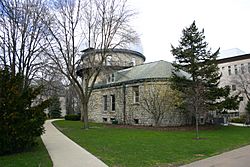Dearborn Observatory facts for kids
Quick facts for kids Dearborn Observatory |
|||||
|---|---|---|---|---|---|

The Dearborn Observatory in 2007
|
|||||
| Organization | Northwestern University | ||||
| Location | Evanston, Illinois, U.S.A. | ||||
|
Coordinates
|
42°03.4′N 87°40.5′W / 42.0567°N 87.6750°W
|
||||
| Altitude | 195 meters (640 feet) | ||||
| Established | 1889 (first founding 1862) | ||||
| Website [1] |
|||||
|
|||||
The Dearborn Observatory is a cool place where people study stars and planets. It's an observatory located at Northwestern University in Evanston, Illinois. It was first built in 1888. Later, in 1939, the whole building had to be moved! This was to make space for a new building called the Technological Institute.
This observatory is actually the second one named Dearborn. The first one was at the Old University of Chicago. Inside, you'll find the famous Dearborn 18 1/2 inch refractor. This telescope was once the largest in the United States! It helped discover Sirius B, a tiny companion star to Sirius, the brightest star in our night sky.
Contents
A Famous Telescope's Journey
The Dearborn telescope was first set up in Douglass Park in Chicago. It was inside a tall dome at the old University of Chicago. The Chicago Astronomical Society took over its care in 1887.
By 1889, the telescope was moved to Northwestern University in Evanston. The Chicago Astronomical Society helped run it there. They officially gave the telescope to Northwestern University in 1929.
In 1911, the telescope's original tube and mount were replaced. These older parts were later given to the Adler Planetarium in 1929. Many early records about the telescope were lost. This happened because documents were destroyed in the Chicago Fire of 1871.
The Dearborn telescope was the biggest in the U.S. for a while. But in 1873, a larger 26-inch (66 cm) telescope was built. This new Great Refractor was at the United States Naval Observatory.
How the Observatory Began
The story of the Dearborn Observatory starts in 1862. That's when the Chicago Astronomical Society was formed. They heard about a huge telescope lens being made. This lens was 18 1/2 inches (469.9 mm) wide! At the time, it was the biggest refracting telescope lens in the world.
A man named Frederick Augustus Porter Barnard had ordered the lens. He wanted to build an observatory at the University of Mississippi. The famous company Alvan Clark & Sons in Massachusetts made the lens. But the American Civil War began before the lens could be sent. So, it stayed at Clark's shop.
A Chicagoan named Thomas Hoyne bought the lens for $11,187. He was a founder of the Chicago Astronomical Society. The society wanted the lens for the Old University of Chicago. A special tower was built for it. This building was named the "Dearborn Observatory." It was named after Mary Ann Haven Dearborn. She was the wife of J. Young Scammon, who helped pay for the project.
Construction started in 1863 and finished two years later. The Old University of Chicago managed the observatory. But they had money problems. So, the Chicago Astronomical Society had to fight in court. They won the right to own the telescope and its library.
In 1887, the society made a deal with Northwestern University. They agreed to move the telescope to Evanston. A new observatory was built there to hold it. James B. Hobbs, a member of the Astronomical Society, helped pay for it. The new observatory was designed by Cobb and Frost. It was built using limestone in a style called Richardsonian Romanesque. The first stone was laid on June 21, 1888. The building was officially opened on June 19, 1889. The first director of the observatory at Northwestern was George Washington Hough.
The Chicago Astronomical Society worked closely with Dearborn Observatory for many years. But after the 1929 stock market crash, they had money troubles. They couldn't afford to keep up the observatory. So, on April 30, 1930, they gave the observatory to Northwestern University. They had one condition: the observatory must be open to the public for free.
In 1911, Northwestern decided the telescope needed a newer mount. The old tube and mount were removed. In 1929, these old pieces were sent to the new Adler Planetarium. They are now on display there. The 18 1/2 inch (470 mm) lens itself stayed at Northwestern.
In the summer of 1939, the Dearborn Observatory building was moved. It went about 200 meters (656 ft) southeast to its current spot. This was to make room for the Technological Institute. In 1997, a new aluminum dome was added to the observatory. The building was also fixed up inside and out in 2015.
Northwestern University's astronomy department used to be in Dearborn Observatory. But in 2013, most of them moved to a new part of the Technological Institute. The telescope is still used for astronomy classes. It is also open to the public every Friday night. Professor Michael Smutko is the current director of Dearborn Observatory.
Discovering Sirius B
On January 31, 1862, an American telescope maker named Alvan Graham Clark saw something amazing. He observed a faint companion star to Sirius. This star is now called Sirius B, or "the Pup." He saw it while testing the new 18 1/2 inch great refractor telescope. This telescope was one of the largest at the time. It was the biggest in the United States. The sighting of Sirius B was confirmed on March 8, 1862. This was done using smaller telescopes.
Important Dates
- 1862: Clark discovers Sirius B using the new 18 1/2 inch refractor.
- 1864–1886: The telescope is used in Douglass Park, Chicago.
- 1889: The 18 1/2 inch telescope moves to Evanston, Illinois.
- 1911: The telescope's main lens is put on a new mount and tube.

